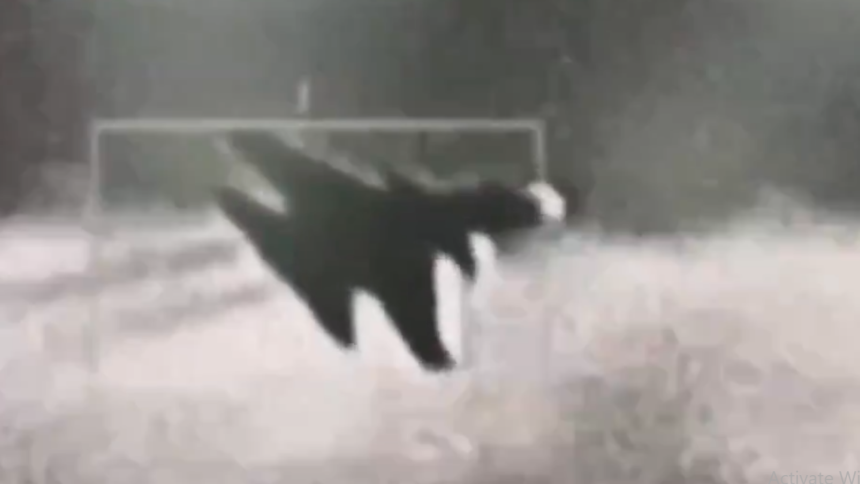The thermal mode video from the RoCAF F-16V’s Sniper ATP shows a Flanker-type aircraft with highly swept canards, confirming that the Chinese jet is a J-15, a derivative of the Russian carrier-capable Su-33 and the mainstay of the PLAN’s multirole missions.
RoCAF (Republic of China Air Force) F-16Vs captured with their Sniper ATPs (Advanced Targeting Pod) a PLA Navy’s J-15 carrier-borne fighter, operating from the Liaoning aircraft carrier as the PRC conducted the Joint Sword-2024B exercises around Taiwan. The drills, which also involved the PLA Air Force (PLAAF), PLA Rocket Force (PLARF) and China Coast Guard (CCG), began early on Oct. 14, 2024, and were announced by the ETC (Eastern Theater Command), mentioning they were to be concluded later in the afternoon the same day.
The Chinese exercises this time were brief, concentrating on “streamlining” minor coordination gaps between the PLAN and PLAAF, according to Global Times. The Chinese reports said the drills included “air and sea readiness patrols, blockades of key ports and strategic areas, coordinated operations to secure air and sea superiority with long-range precision strikes on critical targets.”
The ROC military has deployed appropriate forces to address the threats. Among them, F-16 fighter jets utilize the SNIPER ATP targeting pod to monitor the movements of the PLA ‘s J-15 fighter jets, steadfastly defending airspace security.
#ROC#Taiwan#F-16#airforce pic.twitter.com/BLw0F0GrV9
— Youth Daily News 青年日報 (@YDN_NEWS) October 14, 2024
CGTN news footage showed a PLAAF H-6K bomber, equipped with two K/AKD-63 anti-ship missiles on external hardpoints, and J-10Cs, with a complement of the PL-series of short and long-range air-to-air missiles, taking off from an undisclosed base at the beginning of the exercise. The same video also showed a J-16 and a J-20 stealth fighter taking off and later supposedly flying with Taiwan’s Central Mountain Range visible from their cockpits.
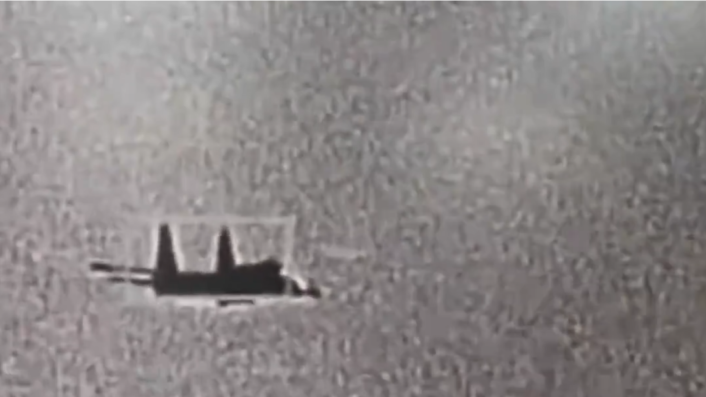
PLA’s PHL-16/PCL-191 MLRS (Multiple Rocket Launch System), assessed to be the leading ground-launched system able to undertake strikes on Taiwanese land targets, also figured in the exercise. The Taiwanese military meanwhile launched its Albatross airborne surveillance drone to watch PLAN movements, and deployed mobile truck-mounted anti-ship cruise missile batteries, in addition to two frigates and an unspecified number of F-16s.
Professor Lin Ying-yu from the Graduate Institute of International Affairs and Strategic Studies at Taiwan’s Tamkang University was quoted saying to Taiwanese media that the timing of China’s Joint Sword 2024-B military drills “appeared to be a test of the U.S. ability to respond to crises in both the Taiwan Strait and the Korean Peninsula simultaneously.”
J-15 from the Liaoning carrier
The Liaoning CSG (Carrier Strike Group) had been operating in the middle and southern parts of the SCS (South China Sea) since early in September. The carrier raised eyebrows when, between Sep. 17 and 18, it clocked approximately 130 take-offs and landings by carrier-based aircraft and around 90 helicopter operations from Sep. 27 to Oct. 1, according to the Japan MoD. This totalled 220 takeoffs and landings in the four-five day period.
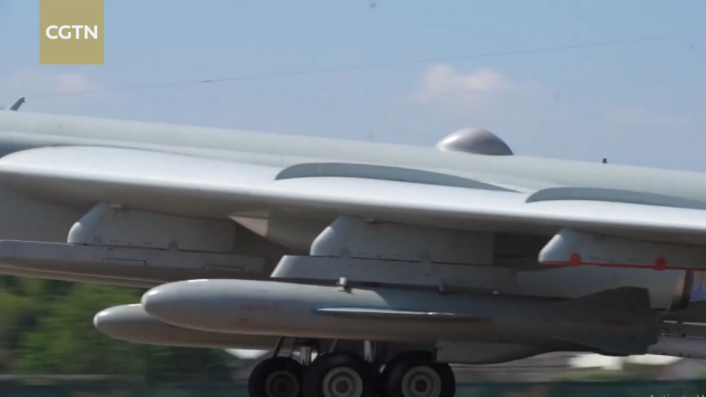
With the general location being deeper into the western Pacific close to Japan’s Ryukyu island-chain that ends a little away from Taiwan’s northeastern waters, the Liaoning presumably stayed there until the Joint Sword drills commenced. On Oct. 13, Taiwan’s Ministry of National Defense reported on X that the Liaoning “sailed through the waters near the Bashi Channel and continued towards the Western Pacific.”
海鋒機動一中隊放列#海軍 #岸置飛彈系統 #守護家園 #中華民國 #臺灣 #ROCArmedForce #ProtectOurCountry #ROC #Taiwan🇹🇼 pic.twitter.com/IjOqvKXAaS
— 軍聞社 Military News Agency, ROC(Taiwan)🇹🇼 (@mna_roc) October 14, 2024
Official PLAN footage showed a J-15 fighter taking off from the Liaoning in low daylight hours. The thermal mode video from the RoCAF F-16V’s Sniper ATP shows a Flanker-type aircraft with highly swept canards, confirming that the Chinese jet is indeed a J-15, a derivative of the Russian carrier-capable Su-33 and the mainstay of the PLAN’s multirole missions. The Aviationist had previously reported how the jet might soon see a dedicated EW-capable variant, like the PLAAF’s J-16D and the U.S. Navy’s E/A-18G Growler.
From its strategic position in the #PLA military drills on Monday, the #Liaoning #aircraft carrier controls a key chokepoint, forming a solid maritime barrier and establishing external blockade and internal pressure, effectively exerting pressure on the “Taiwan independence”… pic.twitter.com/PuQus4jnq1
— Global Times (@globaltimesnews) October 14, 2024
The location where the RoCAF F-16V captured the J-15 on its Sniper ATP was not specified, although it could be somewhere over Taiwan’s eastern and southeastern waters. Whether the RoCAF also scrambled its French-made Mirage 2000 and the F-CK-1 IDF (Indigenous Defense Fighter) is not known.
By 8 am on Oct. 14, Taiwan’s MND detected and tracked 25 PLA aircraft and seven PLAN vessels, of which 16 aircraft crossed the median line and entered the island’s southwestern and eastern ADIZ (Air Defense Identification Zone). RoC armed forces deployed CAP (Combat Air Patrol), navy vessels and coastal missile systems to the detected activities.
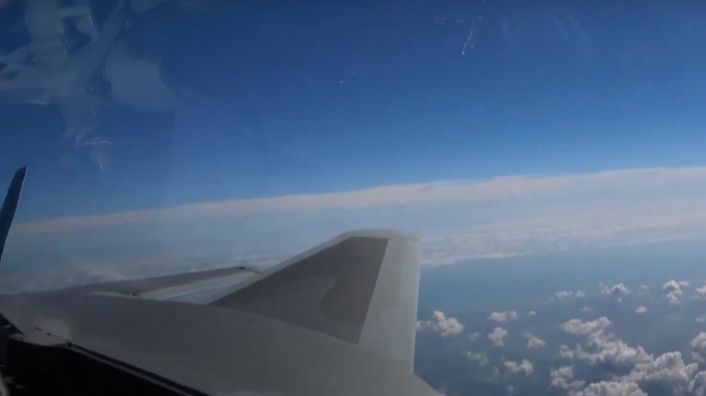
Other Chinese aircraft and maneuvers
CGTN footage also showed a Shaanxi KJ-500A AEW&C (Airborne Early Warning and Control) aircraft taking off. The plane is distinguished by its aerial refueling probe mounted above the cockpit. Another clip showed footage captured from the rear seat of what is possibly a J-16, performing a mid-air refueling from a Y-20 tanker. The KJ-500A and the J-series aircraft being refueled by the domestically developed Y-20 figuring in Taiwan-centric drills is very rare.
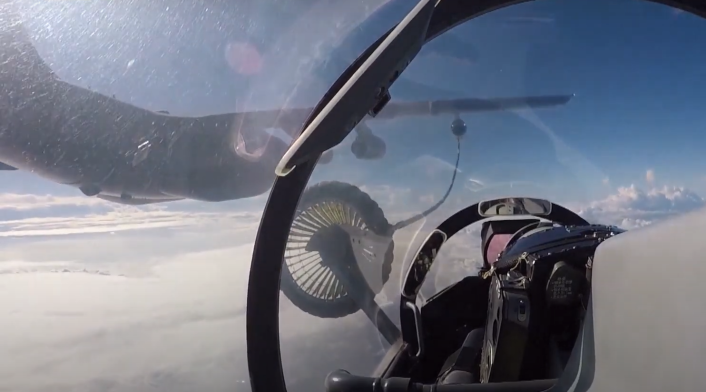
These exercises were also far smaller in intensity and duration than the Joint Sword-2024A drills that the PRC launched late in July this year, or the live-fire maneuvers undertaken in Aug. 2022 in retaliation to former US Speaker Nancy Pelosi’s visit to Taipei.
Tracking AIS data linked to China’s “Joint Sword-2024B” military drill shows a significant number of Chinese Coast Guard vessels operating around Taiwan a short while ago pic.twitter.com/AZfxxH6CjS
— Damien Symon (@detresfa_) October 14, 2024
The ETC’s spokesperson, Senior Captain Li Xi, highlighted the centrality of the Liaoning carrier to the drills. The command is employing the “Liaoning aircraft carrier formation to conduct exercises with the army, navy, air force and firepower in the sea and air space east of Taiwan, focusing on testing the integrated linkage of internal and external lines and the joint combat capabilities of various services and arms,” said the statement.
【Video】Footage shows multiple types of armed aircraft from the Chinese #PLA Eastern Theater Command Air Force are taking off and heading to the drills surrounding #Taiwan island on Monday. (Video: PLA Eastern Theater Command Sina Weibo account) pic.twitter.com/MDQaJSXAVV
— Global Times (@globaltimesnews) October 14, 2024
The army, navy, air force and rocket force drills emphasized work on “vessel-aircraft cooperation, joint air control, and strike on maritime and ground targets in the waters and airspace to the east of Taiwan Island,” as the exercise’s goal was to “test integrated operations inside and outside the island chain by multiple services.”

